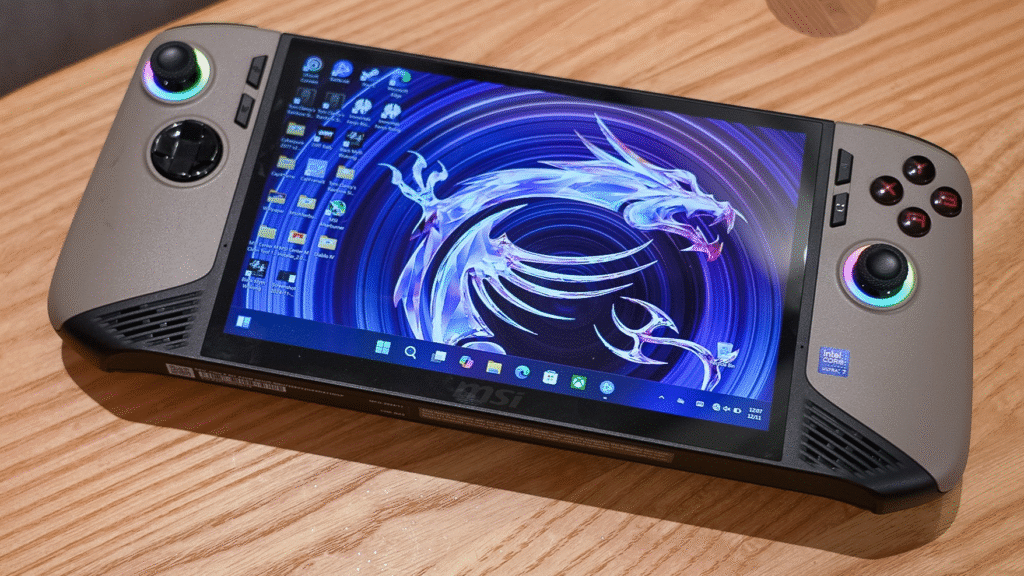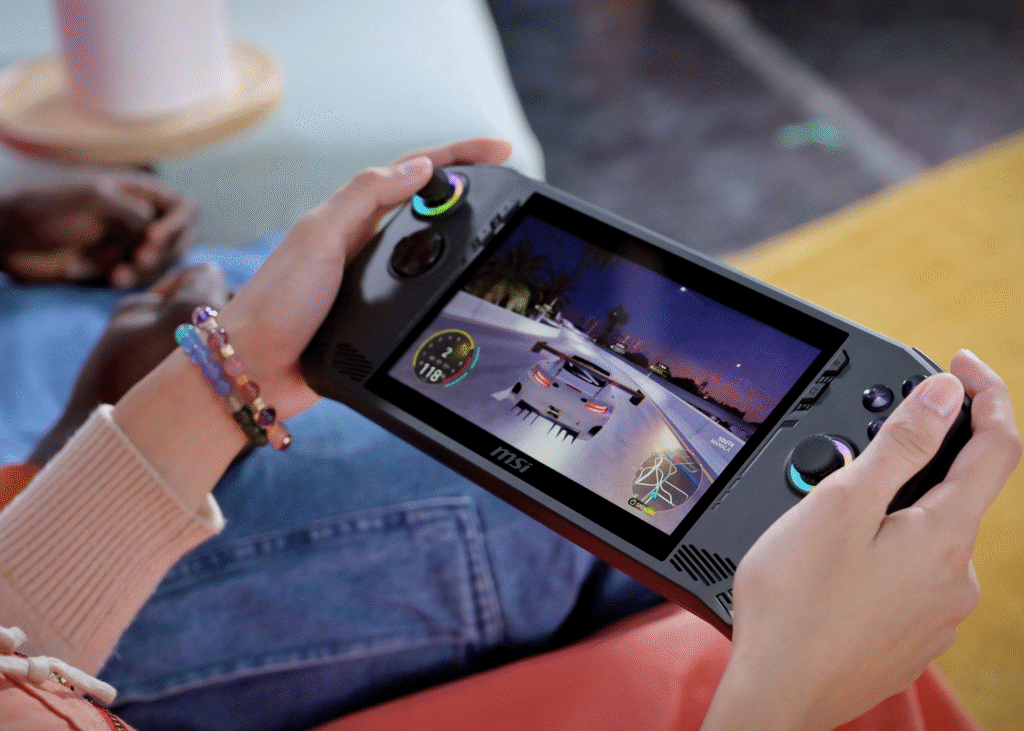The advent of handheld gaming PCs is perhaps the most thrilling trend in the gaming world. In a market long controlled by consoles and high-performance desktops, products like the Steam Deck and ROG Ally have brought with them a new type of
gaming freedom—play anywhere, lose little power. MSI, whose brand name has become synonymous with gaming laptops and desktops of the highest performance, has now entered the fray with the MSI Claw. It is the first handheld gaming platform from this company, and it’s already creating quite a buzz. The MSI Claw is more than simply an entrant; it’s a declaration that handheld PC gaming is not a myth, on the rise, and is open to competition.

On first impression, the MSI Claw is the familiar shape of other gaming PCs held in hand. It has the console-like grip, built-in controls, and broad screen that looks like a N in ten do Switch or Steam Deck. But beneath that form is an ambitious engineering project tode liver Windows gaming in your hands with fewer compromises than before. MSI isn’t
entering the fray—they’re setting the tempo.
Design that Combines Power with Ergonomics
MSI has obviously done its research on the competition. The Claw feels and looks like a tried-and-true design, not an initial effort. Its construction is high-end, with a rugged body that has padded edges and rubberized grips to cradle it comfortably in your hand during extended gameplay sessions. Unlike some handhelds that are essentially
miniaturized laptops or oversized gamepads, the Claw finds a happy mediumwithsize, weight, and grip. What really stands out is its thoughtful ergonomics. The device sits naturally inthehands, and the controls are spaced out just right. MSI didn’t go overboard tryingtocramin extra buttons or touchpads, and the result is a clean, intuitive layout. The joysticksare
responsive, the triggers have a satisfying click, and the buttons offer just the right amount of resistance. Whether you’re playing fast-paced shooters or indie platformers, the Claw feels right. The 7-inch Full HD touchscreen .The 7-inch Full HD touchscreen enhances the gaming immersion. With its 120Hzrefresh rate and 500 nits of brightness, the screen is sharper and more responsive than a lot of competitors in its category. Games appear crisp, motion is smooth, and visual are clear even in extremely bright environments. This is a screen built for actual gaming, not a reduced panel borrowed from a cheaper tablet.
The Intel Arc Gamble—And Its Unlikely Pay off
One of the gutsiest things MSI did with the Claw was its decision to power it with Intel’s Meteor Lake processors and built-in Arc graphics. Nearly every other hand held gaming PC settles on AMD’s Ryzen Z1 series, which has already been battle-tested in units like the ROG Ally. By choosing Intel, MSI is playing a gamble—and so far, it’s paying dividends. The Claw features the Intel Core Ultra 7 155H, a 16-core processor that features Intel’s newest Arc GPU architecture. This combination enables stunning multitasking, power management, and graphics performance, all within a small thermal envelope. Initial doubts regarding Intel’s capacity to contend with mobile game graphics are yielding to astonishment as the Claw provides consistent frame rates in AAA games at medium to high settings. Where this performance stands out is in its consistency. With the implementation of XeSS (Xe Super Sampling), Intel’s response to AMD’s FSR and NVIDIA’s DLSS, the Claw is able to upscale lower resolutions in real-time with little loss in performance. This allows for smoother gameplay without giving up too much visual fidelity.

Battery Life That’s Ready for the Long Game
Battery life has long been the weakness of powerful portables. Nobody likes to be plugged in playing on the move, but high-end chips and high-refresh screens typically come at the expense of something. MSI addresses this with a 6-cell, 53Wh battery that
is one of the largest available in handheld gaming.
In relaxed indie games or when playing from the cloud, the Claw can handily gobeyondthe 7-hour mark. In more challenging AAA games played locally, you’re seeing around2to 3 hours of battery life at max settings, which is comparable or a bit higher than the competition. Fortunately, the Claw has USB-C PD fast charging support, so you can instantly refill the battery during a lull. MSI has also added in customizable performance modes that allow users to adjust their power draw on the fly. Silent mode to full tilt, the Claw provides gamers with control
over longer life or frame rates. This level of control is necessary for a hand held unit, and it turns the Claw into something more than a plug-and-play system—it’s a tool for power users.
Cooling That Punches Above Its Size
Thermals are another challenge for handheld gaming PCs. Cramping desktop-class performance into a small form factor often leads to overheating and throttling. But MSI’s experience building high-end laptops is evident in the Claw’s cooling system. The device uses a custom Cooler Boost Hyper Flow design, with dual fans and dedicated heat pipes to manage temperature efficiently. Even with heavy loads, the Claw is comfortably warm but not noisy or distracting. Fan noise is also well managed, and the unit infrequently encounters thermal ceilings that affect frame rates. Such thermal engineering in a unit so small is no minor accomplishment, and it solidifies the Claw’s reputation as an actual gaming machine, not a merely entertaining experiment.
Software That Brings It All Together
One of the areas where handheld Windows PCs tend to struggle is user interface. Navigating a full Windows desktop with tiny touchscreen buttons isn’t ideal. MSI addresses this with its MSI Center M interface, a custom launcher designed to provide quick access to games, settings, performance modes, and updates. The 7-inch display is served with a fast and clean interface that is optimized for the screen size. Switching between performance profiles, launching games, mapping controllers, or viewing battery levels is easy without having to navigate Windows menus. The addition of customizable shortcuts and profiles also simplifies setting up configurations meant for particular games or game genres. And since this is a complete Windows device, you’re not confined to MSI’s ecosystem. You can use third-party tools, install mods, or even dual boot if you dare. That free domis what distinguishes the Claw from more console-oriented handhelds. It allows userstodo things their way, without arbitrary constraints.
A Handheld for the Future of PC Gaming
MSI didn’t aim to compete—MSI aimed to make something that feels future-proof. With Wi-Fi 7, quick storage, and driver support that only improves, the Claw is a long-term investment. Its combination of portability, performance, and flexibility is a reflection of the increased need for gaming on your own terms—where you want and when you want. The presence of Hall-effect triggers, which eliminate drift and wear common to analog sticks in most games, is another indication that MSI was detailing-focused. These kinds of little things count on a product intended for everyday use and constant carrying. There silience , input precision, and hardware response all seem to indicate that this is a product made for actual gamers, not merely tech demo enthusiasts.

Challenges and Opportunities
The Claw is not flawless. There are still games that grapple with Intel’s drivers, particularly older games or those which are optimized around NVIDIA or AMDAPIs. Thecost point, although competitive, might also be a concern for casual players who might
prefer the lower-cost Steam Deck or even a Nintendo Switch. And although MSI’s software overlay makes it more convenient to use, there’s always an awkward moment that reminds you that you’re essentially running full Windows on a small screen. But they’re small imperfections on an otherwise impressive launch. What MSI has done with the Claw is not only credible—it’s thrilling. They’ve proven that PC gaming in handheld form isn’t a gimmick. It’s an area that allows for development, innovation, and real competition. As driver support comes of age and more developers begin optimizing for a range of PC hardware, the Claw will continue to improve.
